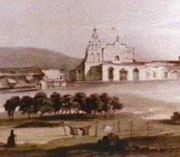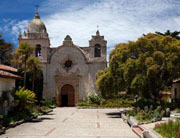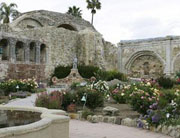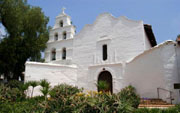VOA慢速英语2011--Visiting the Beautiful Missions Along California’s Coast
时间:2019-01-04 作者:英语课 分类:2011年VOA慢速英语(十二)月
EXPLORATIONS - Visiting the Beautiful Missions 2 Along California’s Coast
FAITH LAPIDUS: I’m Faith Lapidus.
STEVE EMBER: And I’m Steve Ember with EXPLORATIONS in VOA Special English. Today, we tell about the first attempts to settle what is now the western state of California. These attempts began with Spanish settlers who built twenty-one Catholic 3 churches called missions. Our report is about those churches -- the missions of California.
(MUSIC)
FAITH LAPIDUS: Our story begins in seventeen sixty-eight in Madrid, Spain. The king of Spain, Charles the Third, had recently received reports that worried him. The reports said Russian explorers were in the northern part of the territory called California. Spain had claimed most of that area more than two hundred years earlier. But Spain had no settlements in California. King Charles knew if the Russians began to settle the area, Spain might lose control of California forever.
STEVE EMBER: King Charles decided 4 the best way to keep the Spanish claim to California was to build settlements there. California had good harbors 5 for Spanish ships, good weather and good farmland.
King Charles decided to order the creation 6 of a series of small farming communities along the Pacific Ocean coast of California. The settlements would provide trade and grow into larger cities. Spanish citizens might want to settle there. Then the Spanish claim to California would be safe.
FAITH LAPIDUS: But there was no one on the coast of California to begin the work. King Charles and his advisors 7 decided that the farming settlements would begin with churches called missions. Missions were places where Roman Catholic religious leaders converted 8 people to the Christian 9 religion. They taught the religion to people who wanted to become members of the church.
King Charles decided Roman Catholic priests 11 would build the missions and settlements with the help of Native American Indians. The priests would teach the native people the Christian religion, the Spanish language and how to farm.
A religious group within the Catholic Church called the Franciscans would build the settlements. The Franciscans chose a young priest 10 named Junipero Serra to begin the work.
STEVE EMBER: Many history experts say the Spanish government and the Catholic Church could not have chosen a better person for the task than Junipero Serra.
Junipero Serra was born in seventeen thirteen on the island of Mallorca, Spain. After he became a Franciscan priest, he taught at a university in Mallorca.
Father Serra had always wanted to be a missionary 12. In seventeen forty-nine he sailed to Mexico to begin his life as a missionary. He spent several years studying the languages and customs of native people in Mexico.
In seventeen sixty-eight he was given the job of building the first of the California missions near the present day city of San Diego.
(MUSIC)

A historic 13 picture of San Diego de Alcala
FAITH LAPIDUS: Mission San Diego de Alcala began on July sixteenth, seventeen sixty-nine. But before the mission was completed, Father Serra decided to move it. He did not like the way Spanish soldiers mistreated the Native Americans. He wanted to keep them separate. He moved the mission to an area that is still called Mission Valley.
The design of Mission San Diego de Alcala was similar to each of the missions that were built later. There was a large church building. A long wall formed a large square to the side and behind the church. Large rooms inside and along the wall served as bedrooms, cooking areas, workshops, and classrooms. Usually, the center of the large square was left open. A garden with flowers was planted there.
STEVE EMBER: Junipero Serra’s plan for the missions along the California coast was simple. Each would be about the same distance from each other. Members of the Franciscan religious group did not ride horses or travel in wagons 14. They walked. The missions were built about one day’s long walk from each other. This made it easier to travel, trade goods and share information.
The missions begin with San Diego de Alcala in the south. They end with San Francisco Solano about one thousand fifty kilometers to the north. In time, the road from mission San Diego de Alcala to mission San Francisco Solano was given a name.
The Spanish name is still used today. It is “El Camino Real.” It means the “The Royal Highway” or “The King’s Highway.” Most of that old road is now part of the California highway system. Millions of people use the road every day as they drive from San Diego to San Francisco.
(MUSIC)
FAITH LAPIDUS: Many people have criticized 15 the mission system of settlement because it changed the way of life for the Native Americans in California. Critics say many Native Americans were forced to work at the missions.
They say many were forced to become members of the Christian religion. And many were treated badly by Spanish soldiers and died because of mistreatment or disease 16.
However, other experts say that Junipero Serra demanded that the priests and soldiers treat the Native Americans with respect. Many of the Native Americans accepted the Christian religion, learned 17 to farm and helped the missions become valuable settlements.
Many other Native Americans did not. Some did not want to change the way they lived so they moved away from the missions. Many Native Americans believed they would be forced into a new way of life. In seventeen seventy-six, a group of Indians attacked the San Diego mission and burned it. Eight months later, the mission was rebuilt where it still stands today.

Mission San Carlos Borromeo de Carmelo where Junipero Serra was buried
STEVE EMBER: King Charles’s plan was a success. Settlements grew from the missions along the California coast. Some of those along El Camino Real became major cities -- San Diego, Los Angeles, Santa Barbara, San Jose, and San Francisco, to name only a few.
Junipero Serra was responsible for building nine of the missions. One of these was Mission San Carlos Borromeo del Rio Carmelo in the present city of Carmel.
It became his headquarters 18 and the headquarters for all of the California missions. In seventeen eighty-four, Junipero Serra died of tuberculosis 19 at mission San Carlos. He was buried in the floor of the Mission San Carlos Church.
(MUSIC)
FAITH LAPIDUS: The missions of California faced difficult times during the eighteen hundreds. In eighteen twenty-two, California became part of Mexico, which had just won its independence from Spain. But the Mexican government could not pay the cost of keeping the missions.
In eighteen thirty-four, the Mexican government sold much of the mission land and some of the buildings. Several missions remained part of the communities they helped to build. But many became little more than ruins. Some of the land and the missions were returned to the Catholic Church.
In the eighteen forties, Mexico had trouble controlling the American settlers in California. In eighteen forty-six, the settlers declared California a republic. Less than two years later, the United States gained control of California during the Mexican War.
During this period, the Catholic Church tried to keep control of the missions. They were only partly successful. However, in eighteen sixty-three President Abraham Lincoln signed a law that said all twenty-one missions in California would be returned to the Catholic Church. They have remained so ever since.
STEVE EMBER: Today, the people of California consider the missions a treasure. Eighteen of the twenty-one are still active Catholic churches.
All of the missions are museums that teach the early history of California. Many visitors come to the missions to see the beautiful buildings. Several of the missions have become famous. One example is the Mission San Juan Capistrano. It was planned and built by Junipero Serra.

Mission San Juan Capistrano
Each year, on the same day, at almost the same hour, thousands of birds called swallows return to the mission. They return from their winter homes thousands of kilometers to the south. The swallows arrive on March nineteenth. They build nests and raise their young in the old mission. They leave on October twenty-third.
One story says the birds have been late only once because of a storm at sea. Everyone agrees that Junipero Serra would have loved the beautiful swallows of Capistrano.
(MUSIC: “When The Swallows Come Back to Capistrano”)
FAITH LAPIDUS: This program was written by Paul Thompson. It was produced by Mario Ritter. I’m Faith Lapidus.
STEVE EMBER: And I’m Steve Ember. Join us again next week for Explorations in VOA Special English.
- He was charged with an important mission.他受委托承担一项重要使命。
- I'll leave you to undertake an important mission.我要让你承担一项重要使命。
- The enemy airmen kicked up at the orders to fly more missions. 敌方飞行员开始对执行更多飞行任务的命令表示不服。 来自《简明英汉词典》
- During the spring of 1943, the British missions were strengthened. 在一九四三年春季,英国代表团加强了。 来自辞典例句
- The Pope is the supreme leader of the Roman Catholic Church.教皇是罗马天主教的最高领袖。
- She was a devoutly Catholic.她是一个虔诚地天主教徒。
- This gave them a decided advantage over their opponents.这使他们比对手具有明显的优势。
- There is a decided difference between British and Chinese way of greeting.英国人和中国人打招呼的方式有很明显的区别。
- And, across the world, ships were sliding out of Black Sea harbors. 在世界的那一边,船只正在偷偷地溜出黑海港口。 来自辞典例句
- It harbors huge reserves of capital in the insurance companies of Hartford. 它有哈特福德的保险公司的庞大的储备资金。 来自辞典例句
- Language is the most important mental creation of man.语言是人类头脑最重要的产物。
- The creation of new playgrounds will benefit the local children.新游戏场的建立将有益于当地的儿童。
- The governors felt that they were being strung along by their advisors. 地方长官感到他们一直在受顾问们的愚弄。 来自《现代汉英综合大词典》
- We will consult together with advisors about her education. 我们将一起和专家商议她的教育事宜。 来自互联网
- The hotel is going to be converted into a nursing home. 那家旅馆将被改建成私人疗养院。
- He's living in a converted loft in lower Manhattan. 他住在下曼哈顿的一间改建的阁楼里。 来自《简明英汉词典》
- They always addressed each other by their Christian name.他们总是以教名互相称呼。
- His mother is a sincere Christian.他母亲是个虔诚的基督教徒。
- He confessed to a priest that he had sinned.他向神父忏悔他犯了罪。
- The priest visited all the old people in the parish.牧师探望了教区里的所有老人。
- the ordination of women priests 女司祭的授职礼
- The clergy remain divided on the issue of women priests. 在女性教士的问题上,牧师们意见不一。 来自《简明英汉词典》
- She taught in a missionary school for a couple of years.她在一所教会学校教了两年书。
- I hope every member understands the value of missionary work. 我希望教友都了解传教工作的价值。
- This is a historic occasion.这是具有重大历史意义的时刻。
- We are living in a great historic era.我们正处在一个伟大的历史时代。
- The wagons were hauled by horses. 那些货车是马拉的。
- They drew their wagons into a laager and set up camp. 他们把马车围成一圈扎起营地。
- The decision was criticized by environmental groups. 这个决定受到了环保团体的批评。
- The movie has been criticized for apparently legitimizing violence. 这部电影因明显地美化暴力而受到了指责。
- The doctors are trying to stamp out the disease.医生正在尽力消灭这种疾病。
- He fought against the disease for a long time.他同疾病做了长时间的斗争。
- He went into a rage when he learned about it.他听到这事后勃然大怒。
- In this little village,he passed for a learned man.在这个小村子里,他被视为有学问的人。
- Several great guns from the headquarters are coming to see us today.总部的几个大人物今天要来看我们。
- The bank has its headquarters in Pairs.这家银行的总行在巴黎。
- People used to go to special health spring to recover from tuberculosis.人们常去温泉疗养胜地治疗肺结核。
- Tuberculosis is a curable disease.肺结核是一种可治愈的病。
